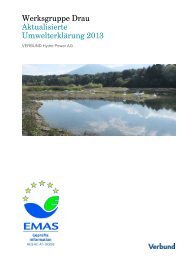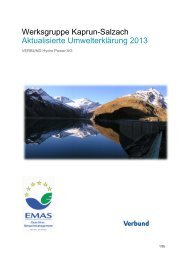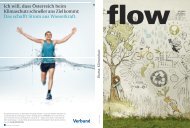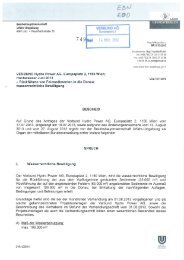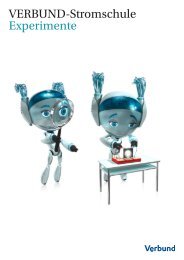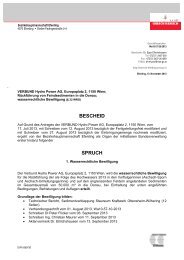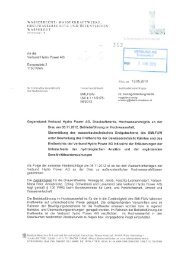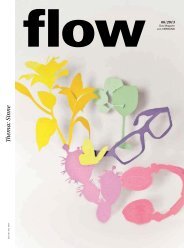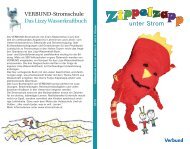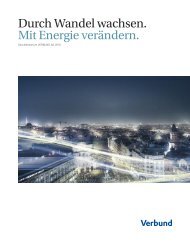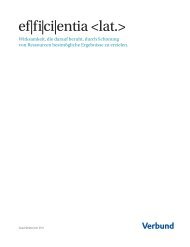Download PDF - Verbund
Download PDF - Verbund
Download PDF - Verbund
Create successful ePaper yourself
Turn your PDF publications into a flip-book with our unique Google optimized e-Paper software.
populations. It took a relatively long time to realise the impact: while in the first half of the 20th century, the<br />
focus during the construction of power plants was the impacts on fishery, since the 1980s and 90s, attention<br />
has shifted to the ecological functionality of water bodies. The importance of diverse species and stable<br />
ecosystems is now widely known.<br />
The effects of hydropower utilisation can be minimised with sophisticated measures. By building functional<br />
fish passes, for instance, the fish are given the opportunity to navigate the barriers and continue<br />
their travels as usual. At the same time, humans can still benefit from the use of water in power<br />
generation.<br />
“Networked river systems” is of critical importance with regard to repopulating revitalised areas, genetic<br />
exchange and balancing out the population flow. Apart from fish migration, it also facilitates the migration<br />
of other species.<br />
While fish passes were built for some older hydropower plants, they were designed with the interests<br />
of fishery in mind. Over the last 20 years, fish passes have been created with the assistance of environmental<br />
experts. Today, it is known that some of the measures taken years ago do not comply with<br />
the latest findings of research. Thus, numerous projects have been launched to improve fish passes in<br />
cooperation with scientists. The findings will be implemented in new and existing power plants.<br />
Fish passes require a great deal of time and expenditure: they need sufficient space and generate higher<br />
maintenance costs due to their need for regular care and adjustments to the channels.<br />
Our brochure on fish passes (published May 2008) is available on our web site www.verbund.at ><br />
Company > Structure > Hydropower > Portrait.<br />
Further measures to minimise the effects of hydropower plants include the design of the power plants’<br />
surroundings based on ecological factors, such as building shallow-water areas and additional bypass<br />
channels. The near-nature fish passes also provide a habitat for other fauna and flora.<br />
CURRENT VERBUND PROJECTS<br />
The estuary of the Traisen will be scaled back to about 12.5 kilometres in length so that it rejoins the<br />
Tullnerfelder Au. This will regenerate typical Au biotopes while ensuring fish can migrate. This EU<br />
project is being sponsored by the state of Lower Austria and via-donau from 2009 to 2014. For more<br />
information, please see www.life-traisen.at<br />
In cooperation with the state of Lower Austria, the EU-LIFE project “Donau-Ybbs Network” aims to link the<br />
section of the Danube in the Wachau region with the upper end of the reservoir of the Melk power plant and<br />
the estuary of the Ybbs.<br />
In the Melk reservoir, <strong>Verbund</strong> added on a fish pass – a near-nature creek, two kilometres long and an<br />
average of 12 metres wide. The walls are made of clay; the river bed was created with stones, wood and<br />
gravel. Construction work concluded by planting a select mix of plants and about 5,000 willows. In 2009,<br />
40 species were already identified by monitors from the University for Natural Resources and Applied<br />
Life Sciences.<br />
The reconstruction of the Ybbs estuary to the Danube is Lower Austria’s contribution to the project,<br />
helping to restore the area as far as possible to its original condition before the regulation. The new side<br />
channels and shallow water areas means the area can reclaim its role as a “nursery” for many types of<br />
fish. For more information, please see www.life-donau-ybbs.at<br />
2010 – THE YEAR OF BIODIVERSITY | SUSTAINABILITY REPORT 2009 | 25<br />
INTERCONNECTING RIVER<br />
SYSTEMS AND CREATING<br />
HABITATS<br />
EU LIFE + PROJECT "HABITAT –<br />
ESTUARY OF THE TRAISEN RIVER<br />
FISH PASS AT MELK POWER<br />
PLANT ON THE DANUBE



